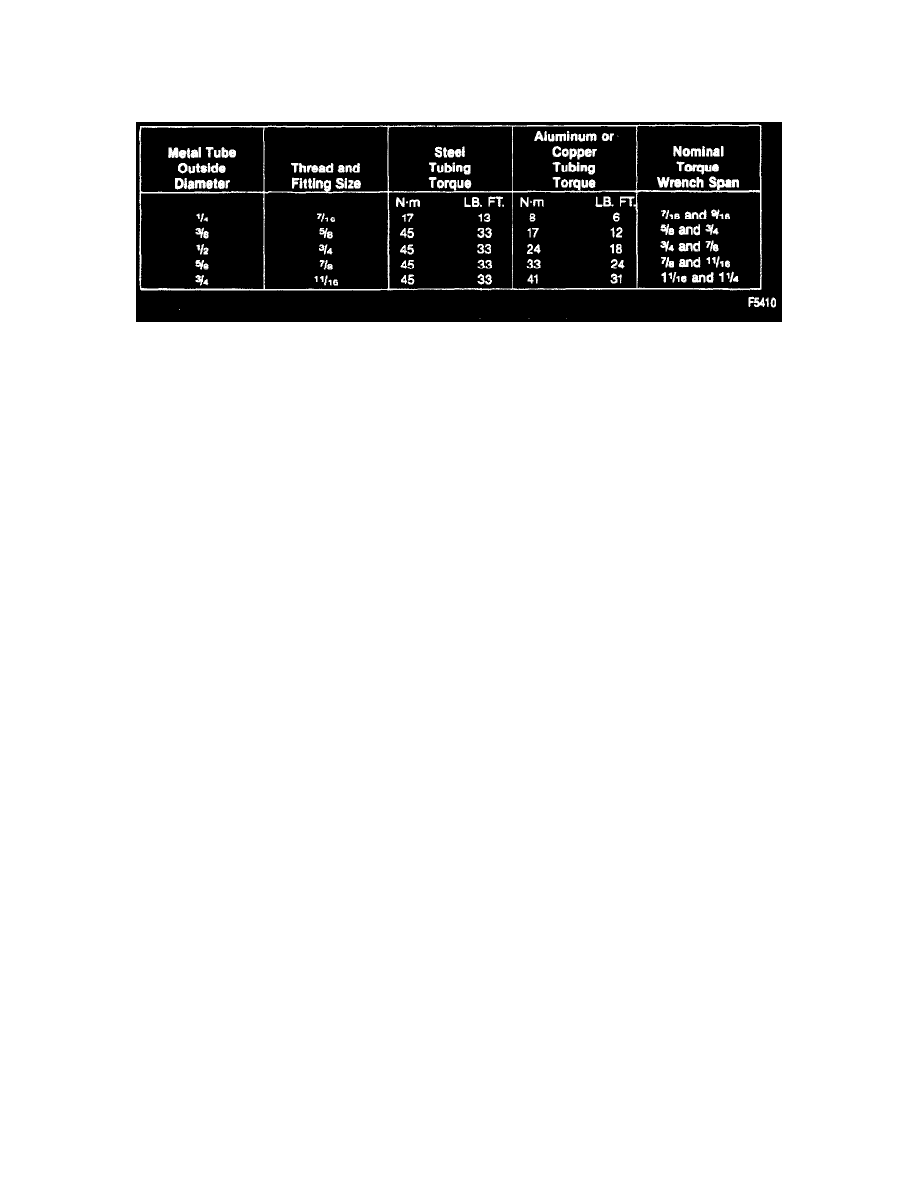S15/T15 4WD P/U V6-262 4.3L VIN W CPI (1992)

Hose/Line HVAC: Vehicle Damage Warnings
Handling of Refrigerant Lines and Fittings
Pipe And Hose Connections Torque
All metal tubing lines should be free of dents or kinks to prevent loss of system capacity due to line restriction.
-
The flexible hose lines should never be bent to a radius of less than four (4) times the diameter of the hose.
-
The flexible hose lines should never be allowed to come within a distance of 63.5 mm (2-1/2 inches) of the exhaust manifold.
-
Flexible hose lines should be inspected regularly for leaks or brittleness and replaced with new lines if deterioration or leaking is found.
-
When disconnecting any fitting in the refrigerant System, the system must be discharged of all Refrigerant-12. However, proceed very
cautiously, regardless of the gage readings. Open very slowly, keeping your face and hands away so that no injury can occur. If pressure is
noticed when a fitting is loosened, allow it to bleed off very slowly.
-
If any refrigerant line is opened to the atmosphere, it should be immediately capped to prevent the entrance of moisture and dirt, which can
cause internal compressor wear or plugged lines, in the condenser and evaporator core and expansion (orifice) tubes or compressor inlet
screens.
-
The use of the proper wrenches when making connections on O-ring fittings, is important. The use of improper wrenches may damage the
connection. The opposing fitting should always be backed up with a wrench to prevent distortion of connecting lines or components. When
connecting the flexible hose connections, it is important that the swaged fitting and the flare nut. as well as the coupling to which it is attached,
be held at the same time using three different wrenches to prevent turning the fitting and damaging the seat.
-
The O-rings and seats must be in perfect condition. The slightest burr or piece or piece of dirt may cause a leak. When replacing the O-ring,
first dip it in clean 525 viscosity refrigeration oil.
-
Tighten tubing connections to the specified torque, refer to accompanying figure.
Maintaining Chemical Stability
The life and efficient operation of the air conditioning system depends on the chemical stability of the refrigeration system. When foreign materials, such
as dirt, air or moisture, contaminate the refrigeration system, they change the stability of the R-12 and 525 viscosity compressor oil. They will also affect
the pressure-temperature relationship and reduce efficiency, and could cause internal corrosion and abnormal wear of moving parts.
The following general practices should be followed to insure chemical stability in the system:
1. Whenever it becomes necessary to disconnect a hose connection, wipe away any dirt or oil at and near the connection to eliminate the possibility
of dirt entering the system. Both sides of the connection should be capped, plugged or taped as soon as possible to prevent the entrance of dirt and
moisture. (It must be remembered that all air contains moisture. Air that enters any part of the refrigeration system will carry moisture with it and
the exposed surfaces will collect the moisture quickly.)
2. Keep tools clean and dry. This includes the Manifold Gage Set and all replacement parts.
3. When adding 525 viscosity refrigerant oil, the container/transfer tube through which the oil will flow should be exceptionally clean and dry due to
the fact that refrigerant oil should be as moisture-free as possible.
4. When it is necessary to "open" an A/C system, have everything needed ready so that as little time as possible will be required to perform the
operation. Do not leave the A/C system open any longer than necessary.
